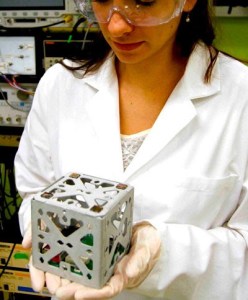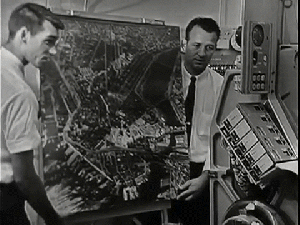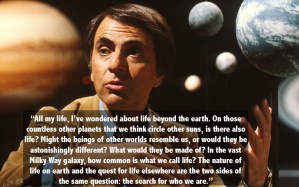Alice Lloyd George
More posts from Alice Lloyd George
At this moment there are more than 500,000 pieces of space debris hurtling around the Earth. Traveling at speeds of up to 40,000 kilometers per hour, a satellite collision with these fragments is enough to damage and even destroy our communications networks.
Accion Systems is building the technology to prevent that. The company, which spun out of MIT in 2014, manufactures ion engines that enable satellites to maneuver in space and avoid these collisions.
In an interview for Flux, I sat down with Natalya Bailey, the co-founder and CEO of Accion Systems. She reveals how the company is able to meet the needs of the burgeoning small satellite industry and why legacy manufacturers can’t keep up, how she’s handled the jump from academia to business and what she’s learned from Bill Swanson of Raytheon about managing a team.
Bailey also discusses how the Apollo mission helped push computing forward, why space exploration is critical for our survival and how to get more women into STEM fields.
An excerpt of the conversation is published below.

AMLG: Today I’m excited to welcome Natalia Bailey, founder and CEO of Accion Systems. Accion was founded three years ago — they build liquid ion systems that power the electric propulsion in satellites. It’s a technology that could change the dynamics in space by enabling satellites to maneuver and reposition, extending their lifetime, which is pretty huge, and could be used for a lot of missions including (one day) interplanetary exploration. Welcome Natalya, great to have you here.
NB: Thanks for having me on the show.
AMLG: Let’s jump in. I’d love to hear how you came to found Accion — how did you get where you are now?
NB: My path to founding Accion started with my interest in studying space propulsion and doing research in the field. That brought me to MIT for my PhD in aeronautics and astronautics.
Actually prior to starting there, I was doing my masters at Duke and tried to start a rocket company, with different technology but similar ideas, and that company kind of imploded. I thought that would be my last go at entrepreneurship and startups, so I went to do my PhD and thought I would end up as a professor or at a research lab. And I started working on this new type of ion engine. We ended up getting a lot of interest from industry. The timing was phenomenal — as we were testing proof of concept of this technology the whole industry was getting more interested in smaller satellites. There was this huge technology gap as far as propulsion goes and we were working on exactly the thing that could fill that gap. We had some of the big aerospace companies, the Lockheeds and the Boeings of the world, coming to MIT and trying to license the technology or buy systems from MIT. My research advisor remembered that I had tried to start a company once before so he knew I had entrepreneurial leanings and suggested I try again.
It was in 2012 that my labmate and I decided to spin out, so we formed a placeholder company to grab the IP. Then I defended my PhD and he dropped out, and we officially spun out in 2014 and hit the ground running.
AMLG: Were you surprised by all the interest coming from these big companies — the Lockheeds, the Boeings? Did you have to ward them off? Was it tempting to license out all the core tech, or did you feel a huge relief that you knew you’d hit on the right opportunity?
NB: Looking back it feels like a pretty clear sign of product market fit. I think it was Marc Andreessen or Ben Horowitz who said, “If the market really wants a technology it will pull it out of a company.” So even if the team is inexperienced and moving slowly and there are other challenges, if the market really wants something, that strong force can make it happen. We also still live under the fantastical notion that no one out there can necessarily manufacture these systems better than we can, because they’re non-traditional for aerospace. There aren’t established manufacturing plants or processes at a Lockheed that could make these technologies better than we can. So that was a neat position to be in.
AMLG: It seems crazy that they don’t have this capability. Is it just too niche for them to allocate resources? What’s the advantage of being a startup doing this?
NB: The technology itself is very different, and the manufacturing. We leverage MEMs fabrication techniques — the same manufacturing lines that are used to make Intel computer processors — we use those to make our thruster chips. A Lockheed, who wouldn’t traditionally be making computer processors, doesn’t have those capabilities set up.
AMLG: So you found this specific niche that they can’t tackle. For listeners that don’t know what a propulsion system on a satellite does, can you explain why it’s so important?
NB: The main application is for onboard propulsion systems, that’s what we’re working on. That’s different from launching from the surface of the Earth. We deal with when the satellite’s already in space. If you look at the progression of a mission, a satellite is launched into orbit on a big bulky rocket that’s not very precise, so first it will have to reposition itself to get where it actually intended to go.
Then over the lifetime of the mission, there are always small disturbances pulling the satellite off of its intended track. It has to correct for those, like gravity and atmospheric drag and other perturbations.
You also have to budget for collision avoidance. If NASA notifies you that you’re on track to collide with something, you’re responsible for moving out of the way. Then at the end of a lifetime of a satellite you’re also responsible for de-orbiting it. You can’t leave a satellite in orbit indefinitely — that’s called space junk and it’s a hot-button topic for us. So that’s one of the most typical missions, but as we start going beyond low-earth orbit, propulsion systems are also useful for transferring orbits, for reaching the moon and Mars and other interplanetary exploration missions.

NB: Ultimately the two main applications are imaging or earth observation and communications. Those are the two main applications commercially that we’ll be addressing. Our initial batch of customers happen to be folks that can tolerate higher risk. We haven’t been launching propulsion systems into space for the past 10 years like some of the more established players would like for their suppliers. So our initial batch of customers are trying to do things like take a small satellite from low-earth orbit to lunar orbit, or trying to demonstrate other novel technology or mission components that haven’t been proven before. So we’re focusing on those higher-risk-tolerance customers right now.
AMLG: You mentioned interplanetary and Mars — a bunch of people in the industry are complaining that SpaceX’s focus on Mars colonization has pulled attention away from regular rocket launches and supporting the ecosystem of near-earth satellites, and those near-earth satellites are probably most of your customer base. What are your thoughts on that?
NB: Two thoughts on that. First, it’s analogous to Apollo in the sense that when you have an incredible, audacious goal that you set out to achieve, the spin-off technologies and other challenges you have to solve along the way are actually extremely beneficial in other areas, not just space. Looking at Apollo, you could even argue that some of the returns on that investment were computers in general, and everything else that came out of that program.
AMLG: What did we get specifically out of Apollo in terms of computer advances?
NB: The personal computer was just starting to be thought of around that time, and in a lot of the early Apollo missions everything was done by hand calculations, then later they started to input the punch hole cards into a computer on board. It was right at that transition point to computing, and a lot of money was being funneled into developing it for Apollo. So fans of Apollo say that computers came about because of that program. I think, in general, setting big hairy goals for an entire nation to achieve usually ends in a lot of cool spin-off technologies.
The other thing about Mars colonization is, if you think about humankind as a species, if we’re around 300-400 years from now, it’s probably not because we stayed put on Earth. For our long-term preservation, it’s worth starting to explore other planets in the solar system, and hopefully eventually beyond that.

AMLG: Where did this interest in exploring other planets come from. You grew up in Oregon right? What was that like and how did you get interested in space?
NB: Growing up in Oregon was great. It was very outdoorsy, I don’t really remember spending any time indoors. I would spend nights outside on my trampoline. In Oregon there’s not a lot of light pollution so I could look at the stars. I would think about aliens and then notice these very solid specks of light moving across the sky and I realized they weren’t airplanes. So I tried to figure out what they could be and realized I was watching the space station. Mostly I wanted to study aliens but my family is quite practical so I decided to combine that with math, which I loved, and ended up in aerospace engineering. I haven’t looked back since.
AMLG: Were you always interested in science? Were your parents interested in science?
NB: Yeah. My dad was a biologist. I was always gathering bugs and studying them and keeping them in tanks in my bedroom until my parents found them. In school I started excelling in math and found that it came easily to me. That combined with the science and alien bit led me to engineering.
AMLG: When you talk about aliens I think of one of my favorite books by Carl Sagan — Contact. I don’t know if you ever watched the movie or read the book, but I picture you like Ellie in that film. She’s this brilliant scientist and stumbles across something big.
NB: I’ve definitely seen it. I’m currently making my way through Carl Sagan’s original Cosmos again.
AMLG: I love the original Cosmos. I’m a huge Carl Sagan fan, I love his voice, he’s so inspiring to listen to. Talking about books, I know you’re an avid reader. Did any books in particular influence you or your path to building Accion?
NB: Well I’m a gigantic Harry Potter fan and a lot of things around Accion are named after various aspects of Harry Potter, including the name Accion itself.
AMLG: Is that the Accio spell? The beckoning spell?
NB: Yes exactly. My co-founder and I were g-chatting late one night on a weekend and looking through a glossary of Harry Potter spells trying to name the company. Accio, the summoning spell, if you add an “N” to the end of it, it becomes a concatenation between “accelerate” and “ion,” which is what we do. That’s the official story of how we named the company, but really it was from the glossary of spells.

[To continue reading, a full transcript of the conversation can be found on Medium.]





























Comment